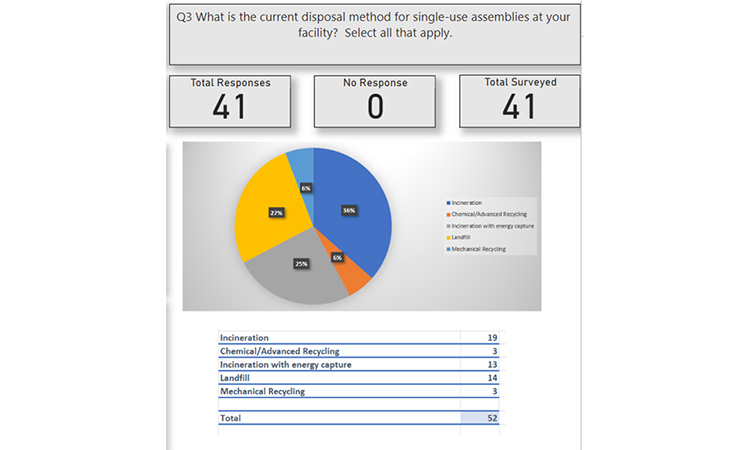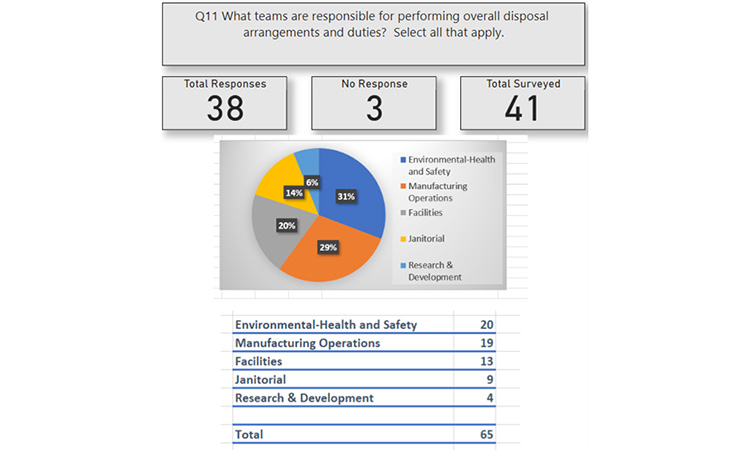End-Of-Life Management for Single-Use Products in Bioproduction

Users Perspective on End of Life Management for Single-Use Products used in Bioproduction
Part 1
Introduction
Single-Use products utilized in the production of biologics provide flexibility that was unimaginable a few years ago. Since their introduction over 25 years ago as a replacement for reusable stainless-steel equipment, the question commonly raised is: What do you do with the Single Use Technology (SUT) consumables once they complete their mission of producing your valuable therapeutics?1
The growing applicability of SUT in manufacturing of biopharmaceuticals has led to large increases in the demand for Single-Use components and assemblies. Once used, the exhausted items are handled by today’s available methods/processes. However, research has shown that most end users feel something better can and should be done.2, 3 More ecological ways already exist to transfer the used products out of the production line and into a process that minimizes the cost and the impact to the environment.
This is a subject frequently discussed by members of the ISPE Disposables Community of Practice (CoP)and more widely within the industry. This provided impetus for the survey whose goal was to identify users’ current practices and views on what they would like to see happen.
The Disposables CoP team initiated our work with a survey of those end users who dispose of single-use assemblies. The survey was distributed via an email communications to ISPE members, a blog on ISPE’s website, and LinkedIn postings.
The Disposables CoP received feedback from small to large firms (>1000 employees) in a survey of the industry’s manufacturers. Management of single-use products after use is important to most manufacturers and many have established sustainability goals for the immediate future. Single-Use products often consist of multiple polymers and non-polymer components. Management of these complex items can be a challenge. In this two-part blog series, we first spotlight a summary of the survey findings of the current status for handling single-use items once they have completed their mission. We then share the results further analyzed to identify future options that may be feasible as the applications for single-use products continue to expand.
Profiles of Companies Surveyed
Overall, there were 41 respondents to the survey. Respondents from across the globe participated in the survey –
- 53% from North America
- 34% from Europe
- 13% from Asia
[Footnote: For those respondents whose region was known]
Showing that SUT waste is an issue recognized in all regions. The participants also represented a good distribution by size of the organizations
- 34% with 0 to 100 employees
- 19.5% with 101 to 300 employees
- 19.5% with 301 to 1000 employees
- 27% with over 1000 employees.
Many of the respondents indicated that their organizations have established goals for environmental sustainability and are committed to improving their practices. Almost half of the respondents (49%) have a corporate sustainability waste goal, this includes organizations in all 3 regions and a cross section of company sizes. In addition, nearly half of the respondents (46%) have initiatives focused on reducing single-use assembly waste and 52% have initiatives on recycling or better end of life management of single-use assemblies. Overall, 27% of respondents have goals or initiatives for all 3.
Current Disposal Practices – Where is the waste going today?
It has been shown that SUT systems have a lower environmental impact as compared to traditional systems which require high purity water and heat needed to clean and sterilize*1. However, while SUT systems provide relief from carbon footprint in energy, it shifts a burden in the SUT manufacturing plants to that of larger waste streams of used plastic.
There are significant challenges for waste disposal and handling at the manufacturing plant level:
- Separation of different types of plastics (some recyclable / some non-compliant materials)
- Management and waste of cardboard and associated dunnage
- Inactivation if considered biohazardous (chemical or heat)
- Staging of materials as process waste in the suites and in holding areas outside of manufacturing
- Limited options for local waste collection or hauling to potential recycling facilities
There are potential opportunities for landfill avoidance through waste to energy (incineration), mechanical recycling (e.g. conversion to plastic lumber), and chemical recycling (chemical breakdown of molecules to create inputs for plastic resin manufacturing).
Greater than 60% of participants currently use incineration as the major disposal method for single-use assemblies, nearly 30% of the end users still dispose via traditional landfilling, and less than 15% utilize any form of chemical or mechanical recycling (note that multiple responses were permitted).
Triumvirate Environmental was one company mentioned that provides recycling services that could accept single-use assemblies in the United States.

This data suggests that there is a large common opportunity for the end user community to come together (> 85%) and work with a consortium of suppliers and recyclers to capture untapped opportunities.
As part of the survey, participants were asked to estimate the total weight of the single-use assembly waste being generated at their facility. The total weight indicated greatly varied, with 1/3 of respondents estimating ~200 kg/month, 1/3 estimating up to 1000 kg/month and the top end for larger users >1000 kg/month. This data suggests that the size of the plant and the throughput of the single-use assembly materials greatly varies.
Current Disposal Practices – Who is managing the waste?
Managing waste at the site level can be complex, time intensive, and a challenge with regards to storage space, logistics flows, and safety considerations. Waste from single-use assemblies are from at least 3 different areas:
- Packaging waste (often expanded polystyrene, plastic bubble wrap and film, cardboard, miscellaneous straps, and adhesive tape)
- The consumable bioprocess container or tubing set,
- Inactivated waste from decontamination including the melted single-use assembly from heat inactivation (autoclaving) and chemical waste from bleach, base, or other inactivation solution.
The specific function within an organization that handles each of the above waste streams at a typical manufacturing site can vary greatly depending on the waste stream and how the facilities’ duties are divided. The survey results indicated that for the respondents only 20% of the handling was performed by facilities teams, approximately 65% of the handling is performed by manufacturing operations and environmental, health, and safety roles – accounting for the highest level of waste management, and the remaining waste is handled via janitorial and research and development functions.
A total of 42% of the respondents selected more than one function, showing that there is a large discrepancy on how waste is handled, by whom and that there are opportunities to streamline the processes.

The above data suggests that due to the complex and sometimes very laborious nature of handling the waste from single-use assemblies, highly skilled and well-paid operators familiar with the use of single-use assemblies spend a great deal of time processing the materials. This can be a deterrent from recycling as it can incur higher costs and loss of efficiency for highly skilled technicians time from the floor where they could be performing more value-added tasks.
Current Disposal Practices – How Is the waste treated prior to disposal?
Removal of Parts in SUS Assemblies/ Complexity
The removal of accessory parts prior to disposal involves significant time and manual efforts. It can also lead to operator Environmental Health and Safety risks. Additionally, if there is no purpose for disassembly, if for example, it does not lead to better end of life disposal options, then this may account for the significant percentage of respondents (63%) that simply dispose without disassembly.
The majority of what is removed from single-use assemblies appear to be metallic, including clamps and metal components (23% of the mentions for both categories (note that multiple responses were permitted)). The study did not indicate whether plastic or metal clamps were being removed prior to wasting the SUT items. Clamps may be removed to facilitate the break-down of assemblies, or, if there is metal, to permit incineration or energy co-generation. Other components removed include PVC, various materials of construction (MOC) types of tubing, (making up 17% of mentions, each), and filters (12% of mentions). Various other components were removed, including sensors, pumps, and rigid plastic parts.
Reasons for Disassembly
Approximately one third of the respondents noted various reasons for disassembly of SUT items. If a facility is employing SUT recycling, it may be necessary to separate out various resin materials to facilitate sorting of the different types of MOC. Because many send their single-use waste out for incineration there may be rules and environmental policy that restricts burning of some types of plastics.
Actual disassembly is typically accomplished by laboratory/operations staff (60%), but 40% of respondents noted their janitorial staff handles these activities.
Successful Best Practices for End-of-Life Management
There were relatively few common threads among respondents regarding their ‘Best Practices’ in single-use assembly end-of-life management.
- A significant number note they rely on reuse of single-use assemblies, e.g., within a minimum number of batches
- A number noted that incineration and energy capture was an optimal solution
- Some felt that regulations required incineration of product contact single-use assemblies, making it the common practice
- Mechanical recycling and conversion to consumer goods such as lumber was noted as viable if transportation factors can make this option economically feasible.
Current Disposal Practices – How are companies dealing with contaminated waste?
The general challenge with laboratory waste is the mix of applications that result in both contaminated and non-contaminated waste. This dictates in part the options for potential recycling of plastic waste. Some organizations have established processes to decontaminate waste where possible, whereas others dispose of it through hazardous waste channels.
We asked survey participants if the single-use assembly waste at their facilities is considered non-hazardous or biological/medical waste after use. Approximately 38% of respondents indicated that all the single-use assembly waste is considered biological/medical waste, 23% indicated it is all non-hazardous waste, and approximately 38% indicated that they have a mix of both. For those that indicated both, nearly 50% of the waste is estimated to be non-hazardous.
For the biological/medical (hazardous) waste that is created, 41% of respondents sterilize the single-use assemblies after use. Various methods are used for decontamination, including use of on-site heat sterilization equipment (53% of mentions), on-site chemical decontamination (33% of mentions), and third-party removal/sterilization (14% of mentions). Sterilization prior to disposal can decrease the costs of disposing of the waste and may offer more opportunity to recycle.
Conclusion:
In Part 1 of this series, we share features of the profiles of the survey participant companies – there was representation from the various regions around the world and small to large companies. Many of the companies represented already have sustainability goals in place. Focusing on the disposal of single-use assembles, a large percentage of the waste is going to incineration and landfill, and this often requires multiple functions to manage. A portion of the materials are decontaminated or are non-hazardous and could potentially have better end of life dispositions such as recycling.
Many single-use advocates and decision makers consider the current methods for disposal of biological single-use assemblies to be less than desirable and unsustainable. The results of the survey confirm the generally held view that current methods are inadequate and that there is currently a lack of more acceptable options. In the upcoming Part 2 of this series, we explore the opportunities to improve end of life management for single-use assemblies.
By ISPE’s Disposables Community of Practice and the Sustainability Sub-Team
View Part 2: End-Of-Life Management for Single-Use Products in Bioproduction Part 2




